Cultural Safety in Healthcare
VerifiedAdded on 2023/01/23
|11
|3280
|87
AI Summary
This document discusses the importance of cultural competence in healthcare and provides strategies for improving knowledge and awareness. It also addresses the unique needs of ethnically diverse and deaf patients and suggests resources for further training. The implementation of cultural competence is explored, along with potential barriers and evaluation methods. The goal is to enhance patient satisfaction and reduce health inequities.
Contribute Materials
Your contribution can guide someone’s learning journey. Share your
documents today.

Running head: CULTURAL SAFETY IN HEALTHCARE
CULTURAL SAFETY IN HEALTHCARE
Name of the Student:
Name of the University:
Author note:
CULTURAL SAFETY IN HEALTHCARE
Name of the Student:
Name of the University:
Author note:
Secure Best Marks with AI Grader
Need help grading? Try our AI Grader for instant feedback on your assignments.
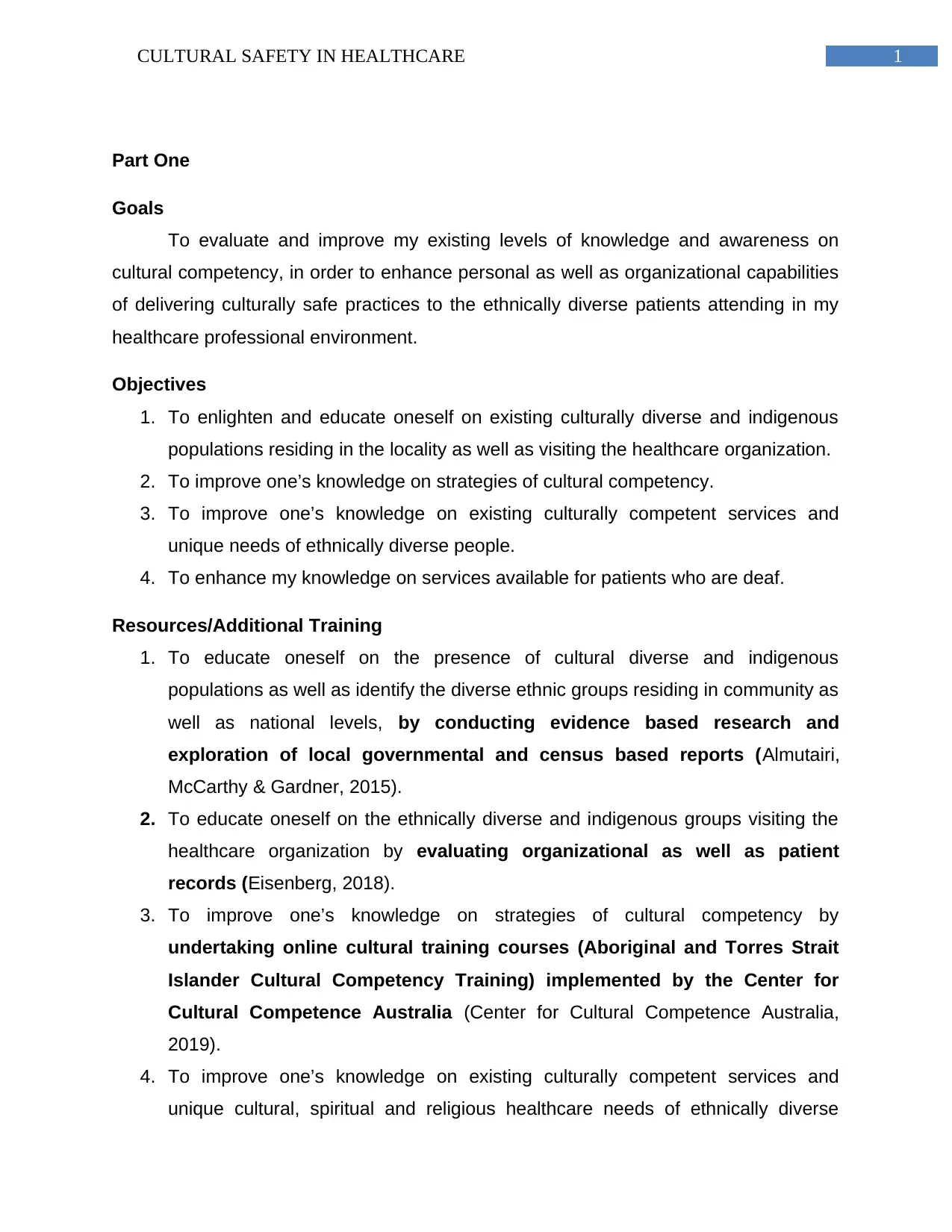
1CULTURAL SAFETY IN HEALTHCARE
Part One
Goals
To evaluate and improve my existing levels of knowledge and awareness on
cultural competency, in order to enhance personal as well as organizational capabilities
of delivering culturally safe practices to the ethnically diverse patients attending in my
healthcare professional environment.
Objectives
1. To enlighten and educate oneself on existing culturally diverse and indigenous
populations residing in the locality as well as visiting the healthcare organization.
2. To improve one’s knowledge on strategies of cultural competency.
3. To improve one’s knowledge on existing culturally competent services and
unique needs of ethnically diverse people.
4. To enhance my knowledge on services available for patients who are deaf.
Resources/Additional Training
1. To educate oneself on the presence of cultural diverse and indigenous
populations as well as identify the diverse ethnic groups residing in community as
well as national levels, by conducting evidence based research and
exploration of local governmental and census based reports (Almutairi,
McCarthy & Gardner, 2015).
2. To educate oneself on the ethnically diverse and indigenous groups visiting the
healthcare organization by evaluating organizational as well as patient
records (Eisenberg, 2018).
3. To improve one’s knowledge on strategies of cultural competency by
undertaking online cultural training courses (Aboriginal and Torres Strait
Islander Cultural Competency Training) implemented by the Center for
Cultural Competence Australia (Center for Cultural Competence Australia,
2019).
4. To improve one’s knowledge on existing culturally competent services and
unique cultural, spiritual and religious healthcare needs of ethnically diverse
Part One
Goals
To evaluate and improve my existing levels of knowledge and awareness on
cultural competency, in order to enhance personal as well as organizational capabilities
of delivering culturally safe practices to the ethnically diverse patients attending in my
healthcare professional environment.
Objectives
1. To enlighten and educate oneself on existing culturally diverse and indigenous
populations residing in the locality as well as visiting the healthcare organization.
2. To improve one’s knowledge on strategies of cultural competency.
3. To improve one’s knowledge on existing culturally competent services and
unique needs of ethnically diverse people.
4. To enhance my knowledge on services available for patients who are deaf.
Resources/Additional Training
1. To educate oneself on the presence of cultural diverse and indigenous
populations as well as identify the diverse ethnic groups residing in community as
well as national levels, by conducting evidence based research and
exploration of local governmental and census based reports (Almutairi,
McCarthy & Gardner, 2015).
2. To educate oneself on the ethnically diverse and indigenous groups visiting the
healthcare organization by evaluating organizational as well as patient
records (Eisenberg, 2018).
3. To improve one’s knowledge on strategies of cultural competency by
undertaking online cultural training courses (Aboriginal and Torres Strait
Islander Cultural Competency Training) implemented by the Center for
Cultural Competence Australia (Center for Cultural Competence Australia,
2019).
4. To improve one’s knowledge on existing culturally competent services and
unique cultural, spiritual and religious healthcare needs of ethnically diverse
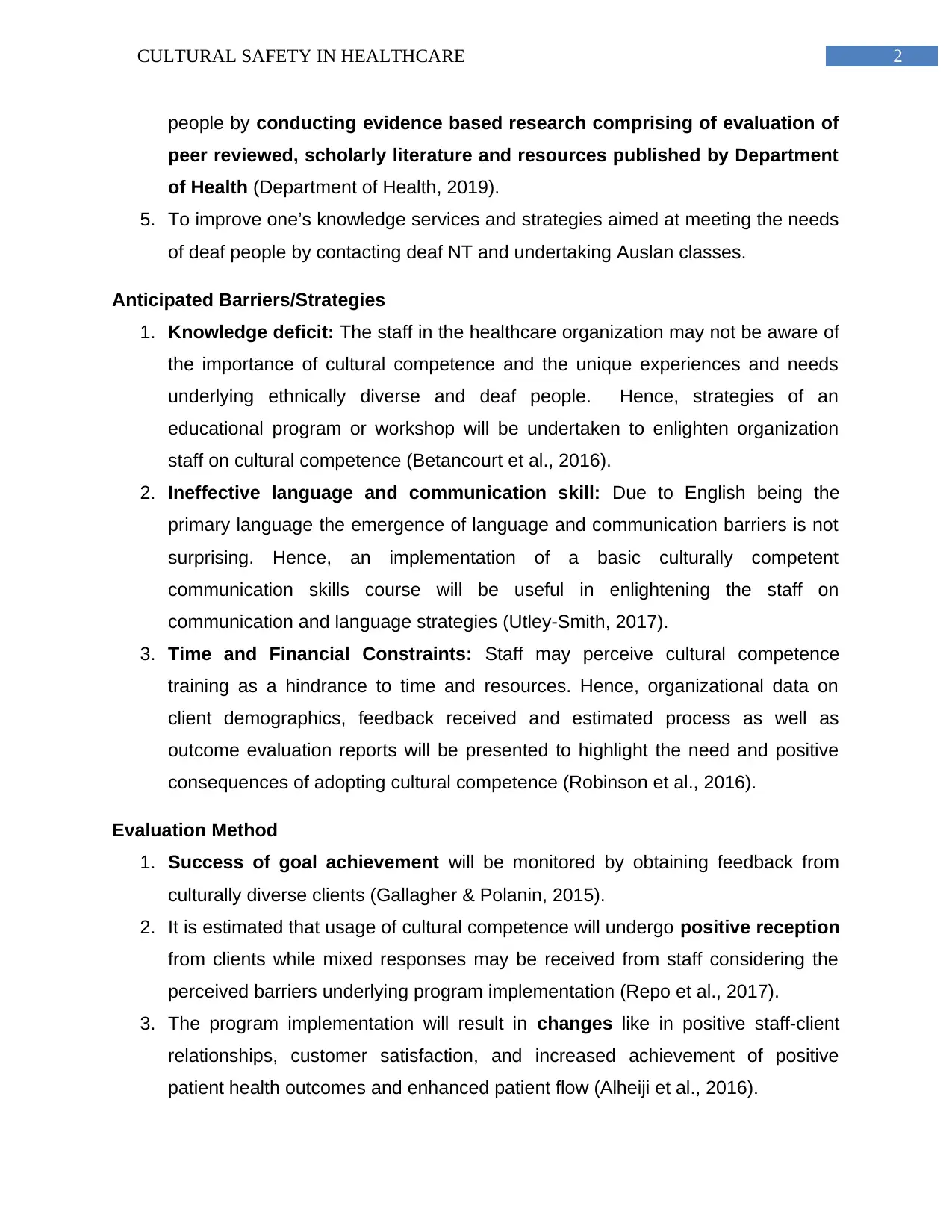
2CULTURAL SAFETY IN HEALTHCARE
people by conducting evidence based research comprising of evaluation of
peer reviewed, scholarly literature and resources published by Department
of Health (Department of Health, 2019).
5. To improve one’s knowledge services and strategies aimed at meeting the needs
of deaf people by contacting deaf NT and undertaking Auslan classes.
Anticipated Barriers/Strategies
1. Knowledge deficit: The staff in the healthcare organization may not be aware of
the importance of cultural competence and the unique experiences and needs
underlying ethnically diverse and deaf people. Hence, strategies of an
educational program or workshop will be undertaken to enlighten organization
staff on cultural competence (Betancourt et al., 2016).
2. Ineffective language and communication skill: Due to English being the
primary language the emergence of language and communication barriers is not
surprising. Hence, an implementation of a basic culturally competent
communication skills course will be useful in enlightening the staff on
communication and language strategies (Utley-Smith, 2017).
3. Time and Financial Constraints: Staff may perceive cultural competence
training as a hindrance to time and resources. Hence, organizational data on
client demographics, feedback received and estimated process as well as
outcome evaluation reports will be presented to highlight the need and positive
consequences of adopting cultural competence (Robinson et al., 2016).
Evaluation Method
1. Success of goal achievement will be monitored by obtaining feedback from
culturally diverse clients (Gallagher & Polanin, 2015).
2. It is estimated that usage of cultural competence will undergo positive reception
from clients while mixed responses may be received from staff considering the
perceived barriers underlying program implementation (Repo et al., 2017).
3. The program implementation will result in changes like in positive staff-client
relationships, customer satisfaction, and increased achievement of positive
patient health outcomes and enhanced patient flow (Alheiji et al., 2016).
people by conducting evidence based research comprising of evaluation of
peer reviewed, scholarly literature and resources published by Department
of Health (Department of Health, 2019).
5. To improve one’s knowledge services and strategies aimed at meeting the needs
of deaf people by contacting deaf NT and undertaking Auslan classes.
Anticipated Barriers/Strategies
1. Knowledge deficit: The staff in the healthcare organization may not be aware of
the importance of cultural competence and the unique experiences and needs
underlying ethnically diverse and deaf people. Hence, strategies of an
educational program or workshop will be undertaken to enlighten organization
staff on cultural competence (Betancourt et al., 2016).
2. Ineffective language and communication skill: Due to English being the
primary language the emergence of language and communication barriers is not
surprising. Hence, an implementation of a basic culturally competent
communication skills course will be useful in enlightening the staff on
communication and language strategies (Utley-Smith, 2017).
3. Time and Financial Constraints: Staff may perceive cultural competence
training as a hindrance to time and resources. Hence, organizational data on
client demographics, feedback received and estimated process as well as
outcome evaluation reports will be presented to highlight the need and positive
consequences of adopting cultural competence (Robinson et al., 2016).
Evaluation Method
1. Success of goal achievement will be monitored by obtaining feedback from
culturally diverse clients (Gallagher & Polanin, 2015).
2. It is estimated that usage of cultural competence will undergo positive reception
from clients while mixed responses may be received from staff considering the
perceived barriers underlying program implementation (Repo et al., 2017).
3. The program implementation will result in changes like in positive staff-client
relationships, customer satisfaction, and increased achievement of positive
patient health outcomes and enhanced patient flow (Alheiji et al., 2016).

3CULTURAL SAFETY IN HEALTHCARE
Part Two: Rationale
Need
Patients belonging to ethnically and culturally diverse family background are in
possession of unique religious, spiritual and health needs which they expect to be
incorporated in their care plan. (Chen et al., 2016). Lack of understanding and
consideration of such culturally sensitive issues, especially in healthcare organizations,
results in perceptions of insecurity and mistrust among such groups further discouraging
their engagement in health services and contributing to societal health inequities (Chiu
& Shi, 2019). Hence, adoption of cultural competence in healthcare, as researched by
Thackrah and Thompson (2013), will result in increased levels of patient satisfaction
and health outcomes among diverse ethnic groups, enhanced healthcare accessibility
and reduced disparities in healthcare. Hence estimated improvements in patient
satisfaction in particular and reductions in societal health inequities form the underlying
need for implementation of cultural competence in the concerned healthcare
organization (Garneau & Pepin, 2015). Similarly, deaf individuals, due to their special
impairments, deaf people possess unique communication needs and must be
encouraged to feel empowered and achieve positive health outcomes through healthy
therapeutic relationships (Kuenburg, Fellinger & Fellinger, 2016).
Implementation
1. The first strategy will include obtaining patient demographics and records of
culturally diverse populations residing in the community. Educating oneself on
diversity of individuals visiting the organization as well as residing in the
community will form the underlying rationale for this strategy (Almutairi, McCarthy
& Gardner, 2015).
2. The second strategy will involve educating oneself on the unique needs, histories
and religious, spiritual and healthcare practices of individuals belonging to
culturally diverse populations. Personal and professional practice improvement
during future engagement with culturally diverse patients will form the rationale
for the same (Sorensen et al., 2017).
Part Two: Rationale
Need
Patients belonging to ethnically and culturally diverse family background are in
possession of unique religious, spiritual and health needs which they expect to be
incorporated in their care plan. (Chen et al., 2016). Lack of understanding and
consideration of such culturally sensitive issues, especially in healthcare organizations,
results in perceptions of insecurity and mistrust among such groups further discouraging
their engagement in health services and contributing to societal health inequities (Chiu
& Shi, 2019). Hence, adoption of cultural competence in healthcare, as researched by
Thackrah and Thompson (2013), will result in increased levels of patient satisfaction
and health outcomes among diverse ethnic groups, enhanced healthcare accessibility
and reduced disparities in healthcare. Hence estimated improvements in patient
satisfaction in particular and reductions in societal health inequities form the underlying
need for implementation of cultural competence in the concerned healthcare
organization (Garneau & Pepin, 2015). Similarly, deaf individuals, due to their special
impairments, deaf people possess unique communication needs and must be
encouraged to feel empowered and achieve positive health outcomes through healthy
therapeutic relationships (Kuenburg, Fellinger & Fellinger, 2016).
Implementation
1. The first strategy will include obtaining patient demographics and records of
culturally diverse populations residing in the community. Educating oneself on
diversity of individuals visiting the organization as well as residing in the
community will form the underlying rationale for this strategy (Almutairi, McCarthy
& Gardner, 2015).
2. The second strategy will involve educating oneself on the unique needs, histories
and religious, spiritual and healthcare practices of individuals belonging to
culturally diverse populations. Personal and professional practice improvement
during future engagement with culturally diverse patients will form the rationale
for the same (Sorensen et al., 2017).
Secure Best Marks with AI Grader
Need help grading? Try our AI Grader for instant feedback on your assignments.

4CULTURAL SAFETY IN HEALTHCARE
3. The third strategy will include personal engagement in cultural competence
workshop which will comprise of educating staff on importance, strategies and
consequences of adopting culturally competent healthcare activities. Enhancing
awareness on needs of culturally diverse populations, the strategies of optimum
cultural competence engagement and the consequences on patient health
outcomes, will form the underlying rationales for this strategy (Butler, 2015).
4. The fourth strategy will involve obtaining feedback from diverse patients visiting
the healthcare organization by conducting interviews. Obtaining information on
the perceived needs, preferences and opinions from diverse patients for
consideration in future practices by the healthcare organization form the
underlying rationale for implementation of this strategy (Alizadeh & Chavan,
2016).
5. The fifth strategy will involve contacting deaf NT and undertaking an Auslan
course to incorporate skills of understanding deaf patients’ needs in patient-
centered care and therapeutic relationships with clients (Deaf NT, 2019). This is
due to the fact that traditional lip reading strategies by health professionals have
been reported to be understood by only 30% of deaf patients (Kuenburg,
Fellinger & Fellinger, 2016).
Resources
1. For implementation of the first strategy, conducting evidence based research and
exploration of local governmental and census based reports, since this resources
will not only present valid, highly credible but will also include updated
information on culturally diverse populations residing in the community, the
nation as well as visiting the concerned healthcare organization (Jani, Osteen &
Shipe, 2016).
2. For the implementation of the second strategy, extensive reading of online
resources on cultural competence published by the Department of Health as well
as peer reviewed, scholarly papers will be required, due to their ability to
provide, credible , updated and valid information with due consideration of
unique experiences and histories of cultural diverse population (Jongen et al.,
2018).
3. The third strategy will include personal engagement in cultural competence
workshop which will comprise of educating staff on importance, strategies and
consequences of adopting culturally competent healthcare activities. Enhancing
awareness on needs of culturally diverse populations, the strategies of optimum
cultural competence engagement and the consequences on patient health
outcomes, will form the underlying rationales for this strategy (Butler, 2015).
4. The fourth strategy will involve obtaining feedback from diverse patients visiting
the healthcare organization by conducting interviews. Obtaining information on
the perceived needs, preferences and opinions from diverse patients for
consideration in future practices by the healthcare organization form the
underlying rationale for implementation of this strategy (Alizadeh & Chavan,
2016).
5. The fifth strategy will involve contacting deaf NT and undertaking an Auslan
course to incorporate skills of understanding deaf patients’ needs in patient-
centered care and therapeutic relationships with clients (Deaf NT, 2019). This is
due to the fact that traditional lip reading strategies by health professionals have
been reported to be understood by only 30% of deaf patients (Kuenburg,
Fellinger & Fellinger, 2016).
Resources
1. For implementation of the first strategy, conducting evidence based research and
exploration of local governmental and census based reports, since this resources
will not only present valid, highly credible but will also include updated
information on culturally diverse populations residing in the community, the
nation as well as visiting the concerned healthcare organization (Jani, Osteen &
Shipe, 2016).
2. For the implementation of the second strategy, extensive reading of online
resources on cultural competence published by the Department of Health as well
as peer reviewed, scholarly papers will be required, due to their ability to
provide, credible , updated and valid information with due consideration of
unique experiences and histories of cultural diverse population (Jongen et al.,
2018).
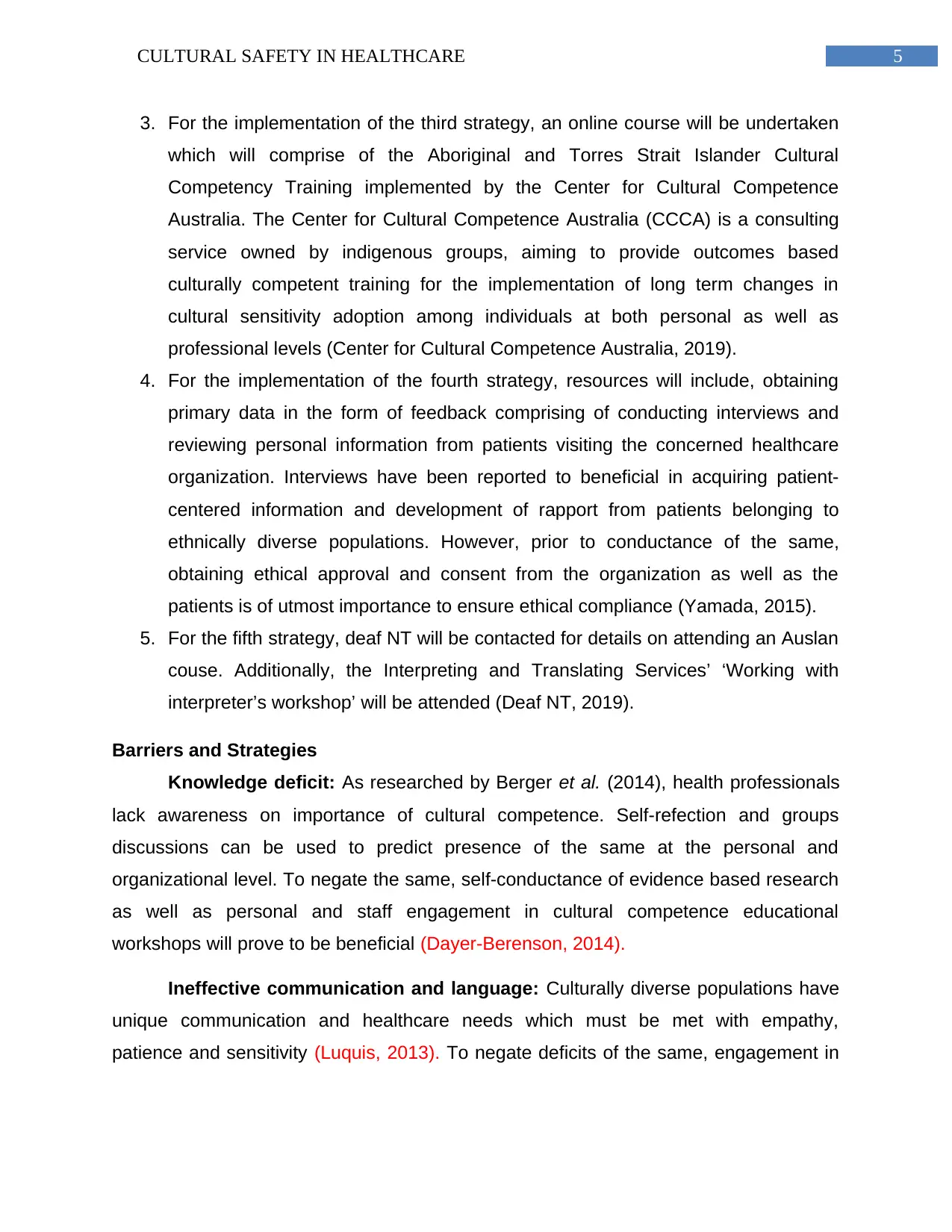
5CULTURAL SAFETY IN HEALTHCARE
3. For the implementation of the third strategy, an online course will be undertaken
which will comprise of the Aboriginal and Torres Strait Islander Cultural
Competency Training implemented by the Center for Cultural Competence
Australia. The Center for Cultural Competence Australia (CCCA) is a consulting
service owned by indigenous groups, aiming to provide outcomes based
culturally competent training for the implementation of long term changes in
cultural sensitivity adoption among individuals at both personal as well as
professional levels (Center for Cultural Competence Australia, 2019).
4. For the implementation of the fourth strategy, resources will include, obtaining
primary data in the form of feedback comprising of conducting interviews and
reviewing personal information from patients visiting the concerned healthcare
organization. Interviews have been reported to beneficial in acquiring patient-
centered information and development of rapport from patients belonging to
ethnically diverse populations. However, prior to conductance of the same,
obtaining ethical approval and consent from the organization as well as the
patients is of utmost importance to ensure ethical compliance (Yamada, 2015).
5. For the fifth strategy, deaf NT will be contacted for details on attending an Auslan
couse. Additionally, the Interpreting and Translating Services’ ‘Working with
interpreter’s workshop’ will be attended (Deaf NT, 2019).
Barriers and Strategies
Knowledge deficit: As researched by Berger et al. (2014), health professionals
lack awareness on importance of cultural competence. Self-refection and groups
discussions can be used to predict presence of the same at the personal and
organizational level. To negate the same, self-conductance of evidence based research
as well as personal and staff engagement in cultural competence educational
workshops will prove to be beneficial (Dayer-Berenson, 2014).
Ineffective communication and language: Culturally diverse populations have
unique communication and healthcare needs which must be met with empathy,
patience and sensitivity (Luquis, 2013). To negate deficits of the same, engagement in
3. For the implementation of the third strategy, an online course will be undertaken
which will comprise of the Aboriginal and Torres Strait Islander Cultural
Competency Training implemented by the Center for Cultural Competence
Australia. The Center for Cultural Competence Australia (CCCA) is a consulting
service owned by indigenous groups, aiming to provide outcomes based
culturally competent training for the implementation of long term changes in
cultural sensitivity adoption among individuals at both personal as well as
professional levels (Center for Cultural Competence Australia, 2019).
4. For the implementation of the fourth strategy, resources will include, obtaining
primary data in the form of feedback comprising of conducting interviews and
reviewing personal information from patients visiting the concerned healthcare
organization. Interviews have been reported to beneficial in acquiring patient-
centered information and development of rapport from patients belonging to
ethnically diverse populations. However, prior to conductance of the same,
obtaining ethical approval and consent from the organization as well as the
patients is of utmost importance to ensure ethical compliance (Yamada, 2015).
5. For the fifth strategy, deaf NT will be contacted for details on attending an Auslan
couse. Additionally, the Interpreting and Translating Services’ ‘Working with
interpreter’s workshop’ will be attended (Deaf NT, 2019).
Barriers and Strategies
Knowledge deficit: As researched by Berger et al. (2014), health professionals
lack awareness on importance of cultural competence. Self-refection and groups
discussions can be used to predict presence of the same at the personal and
organizational level. To negate the same, self-conductance of evidence based research
as well as personal and staff engagement in cultural competence educational
workshops will prove to be beneficial (Dayer-Berenson, 2014).
Ineffective communication and language: Culturally diverse populations have
unique communication and healthcare needs which must be met with empathy,
patience and sensitivity (Luquis, 2013). To negate deficits of the same, engagement in

6CULTURAL SAFETY IN HEALTHCARE
evidence based practice as well as participation in culturally competent educational
courses will prove to beneficial (Forsyth et al., 2019).
Time and Financial Constraints: The additional efforts required to learn cultural
competence skills are perceived as time and resource consuming. Hence, evaluation of
organizational data on client demographics, feedback received and estimated process
as well as outcome evaluation reports will prove to be beneficial in negating such
perceptions and enlightening on association between positive health outcomes and
cultural competence (Salmond, 2018).
Evaluation Reflection
Self-reflection and mindfulness aid in enlightening an individual on the personal
strengths and limitations. Hence, the importance of self-reflection and mindfulness lies
in their ability to enlightening oneself on presence of bias, usage of appropriate
language and provision of a culturally safe environment to patients. Based on insights
from the same, a personal development plan will be implemented to aid cultural
competence improvements (Danso, 2018).
Progress and Outcome Evaluation
The program will be process evaluated by addressing possible barriers and ways
of negating the same as well as personnel, organizations, time and venue responsible
for program direction. Outcome evaluation will involve assessment of patient
perceptions, health outcomes and personal as well as staff levels of awareness on
strategies and importance of cultural competence implementation (Centers for Disease
Control and Prevention, 2019). To evaluate, personal self-reflection and mindfulness
strategies will be conducted during every step of communication with diverse patients
coupled with obtaining feedback from patients in the healthcare organization after
program execution.
evidence based practice as well as participation in culturally competent educational
courses will prove to beneficial (Forsyth et al., 2019).
Time and Financial Constraints: The additional efforts required to learn cultural
competence skills are perceived as time and resource consuming. Hence, evaluation of
organizational data on client demographics, feedback received and estimated process
as well as outcome evaluation reports will prove to be beneficial in negating such
perceptions and enlightening on association between positive health outcomes and
cultural competence (Salmond, 2018).
Evaluation Reflection
Self-reflection and mindfulness aid in enlightening an individual on the personal
strengths and limitations. Hence, the importance of self-reflection and mindfulness lies
in their ability to enlightening oneself on presence of bias, usage of appropriate
language and provision of a culturally safe environment to patients. Based on insights
from the same, a personal development plan will be implemented to aid cultural
competence improvements (Danso, 2018).
Progress and Outcome Evaluation
The program will be process evaluated by addressing possible barriers and ways
of negating the same as well as personnel, organizations, time and venue responsible
for program direction. Outcome evaluation will involve assessment of patient
perceptions, health outcomes and personal as well as staff levels of awareness on
strategies and importance of cultural competence implementation (Centers for Disease
Control and Prevention, 2019). To evaluate, personal self-reflection and mindfulness
strategies will be conducted during every step of communication with diverse patients
coupled with obtaining feedback from patients in the healthcare organization after
program execution.
Paraphrase This Document
Need a fresh take? Get an instant paraphrase of this document with our AI Paraphraser
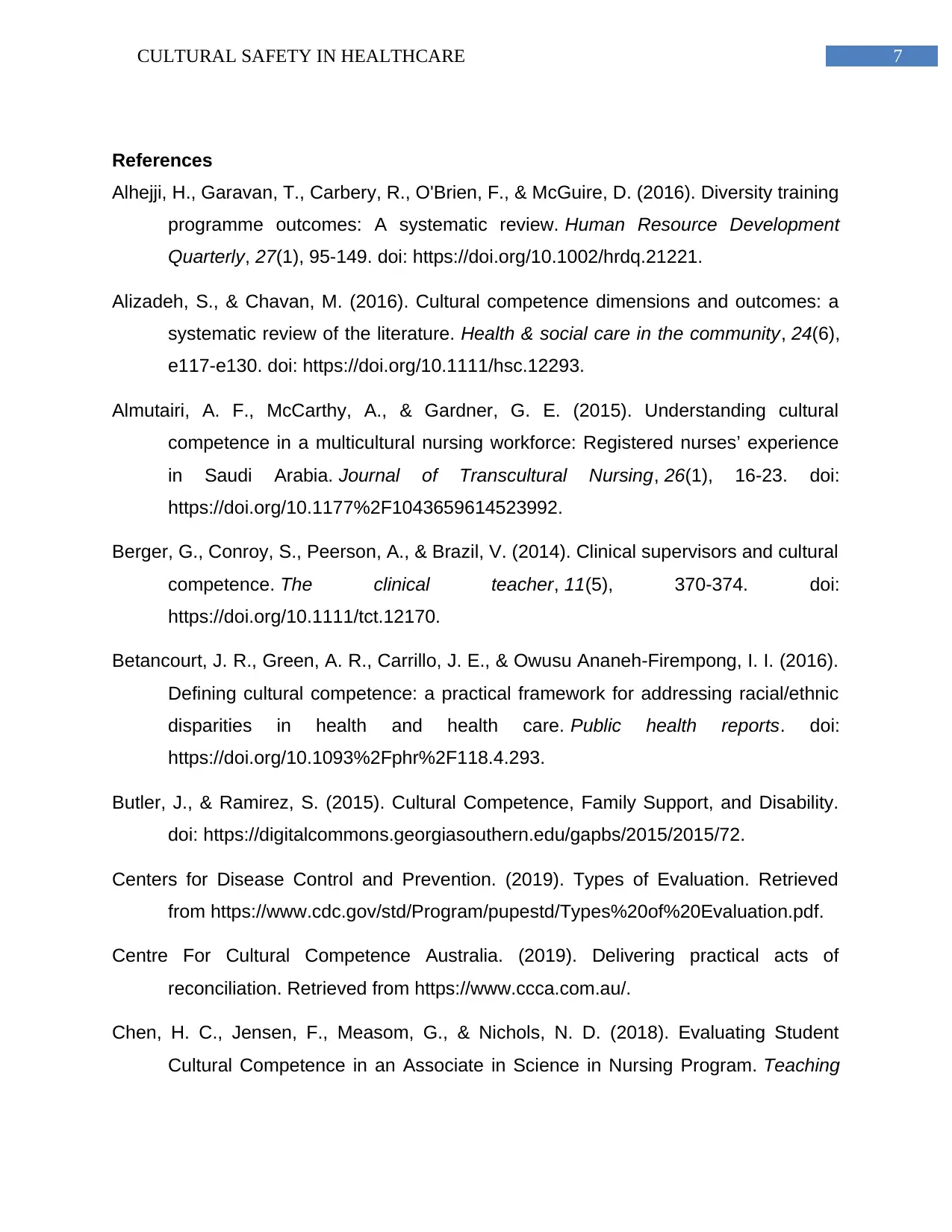
7CULTURAL SAFETY IN HEALTHCARE
References
Alhejji, H., Garavan, T., Carbery, R., O'Brien, F., & McGuire, D. (2016). Diversity training
programme outcomes: A systematic review. Human Resource Development
Quarterly, 27(1), 95-149. doi: https://doi.org/10.1002/hrdq.21221.
Alizadeh, S., & Chavan, M. (2016). Cultural competence dimensions and outcomes: a
systematic review of the literature. Health & social care in the community, 24(6),
e117-e130. doi: https://doi.org/10.1111/hsc.12293.
Almutairi, A. F., McCarthy, A., & Gardner, G. E. (2015). Understanding cultural
competence in a multicultural nursing workforce: Registered nurses’ experience
in Saudi Arabia. Journal of Transcultural Nursing, 26(1), 16-23. doi:
https://doi.org/10.1177%2F1043659614523992.
Berger, G., Conroy, S., Peerson, A., & Brazil, V. (2014). Clinical supervisors and cultural
competence. The clinical teacher, 11(5), 370-374. doi:
https://doi.org/10.1111/tct.12170.
Betancourt, J. R., Green, A. R., Carrillo, J. E., & Owusu Ananeh-Firempong, I. I. (2016).
Defining cultural competence: a practical framework for addressing racial/ethnic
disparities in health and health care. Public health reports. doi:
https://doi.org/10.1093%2Fphr%2F118.4.293.
Butler, J., & Ramirez, S. (2015). Cultural Competence, Family Support, and Disability.
doi: https://digitalcommons.georgiasouthern.edu/gapbs/2015/2015/72.
Centers for Disease Control and Prevention. (2019). Types of Evaluation. Retrieved
from https://www.cdc.gov/std/Program/pupestd/Types%20of%20Evaluation.pdf.
Centre For Cultural Competence Australia. (2019). Delivering practical acts of
reconciliation. Retrieved from https://www.ccca.com.au/.
Chen, H. C., Jensen, F., Measom, G., & Nichols, N. D. (2018). Evaluating Student
Cultural Competence in an Associate in Science in Nursing Program. Teaching
References
Alhejji, H., Garavan, T., Carbery, R., O'Brien, F., & McGuire, D. (2016). Diversity training
programme outcomes: A systematic review. Human Resource Development
Quarterly, 27(1), 95-149. doi: https://doi.org/10.1002/hrdq.21221.
Alizadeh, S., & Chavan, M. (2016). Cultural competence dimensions and outcomes: a
systematic review of the literature. Health & social care in the community, 24(6),
e117-e130. doi: https://doi.org/10.1111/hsc.12293.
Almutairi, A. F., McCarthy, A., & Gardner, G. E. (2015). Understanding cultural
competence in a multicultural nursing workforce: Registered nurses’ experience
in Saudi Arabia. Journal of Transcultural Nursing, 26(1), 16-23. doi:
https://doi.org/10.1177%2F1043659614523992.
Berger, G., Conroy, S., Peerson, A., & Brazil, V. (2014). Clinical supervisors and cultural
competence. The clinical teacher, 11(5), 370-374. doi:
https://doi.org/10.1111/tct.12170.
Betancourt, J. R., Green, A. R., Carrillo, J. E., & Owusu Ananeh-Firempong, I. I. (2016).
Defining cultural competence: a practical framework for addressing racial/ethnic
disparities in health and health care. Public health reports. doi:
https://doi.org/10.1093%2Fphr%2F118.4.293.
Butler, J., & Ramirez, S. (2015). Cultural Competence, Family Support, and Disability.
doi: https://digitalcommons.georgiasouthern.edu/gapbs/2015/2015/72.
Centers for Disease Control and Prevention. (2019). Types of Evaluation. Retrieved
from https://www.cdc.gov/std/Program/pupestd/Types%20of%20Evaluation.pdf.
Centre For Cultural Competence Australia. (2019). Delivering practical acts of
reconciliation. Retrieved from https://www.ccca.com.au/.
Chen, H. C., Jensen, F., Measom, G., & Nichols, N. D. (2018). Evaluating Student
Cultural Competence in an Associate in Science in Nursing Program. Teaching

8CULTURAL SAFETY IN HEALTHCARE
and Learning in Nursing, 13(3), 161-167. doi:
https://doi.org/10.1016/j.teln.2018.03.005.
Chiu, C. Y., & Shi, Y. (2019). Cross‐Cultural Competence. Cross
‐Cultural Psychology:
Contemporary Themes and Perspectives, 39-55. doi:
https://doi.org/10.1002/9781119519348.ch3.
Danso, R. (2018). Cultural competence and cultural humility: A critical reflection on key
cultural diversity concepts. Journal of Social Work, 18(4), 410-430. doi:
https://doi.org/10.1177%2F1468017316654341.
Dayer-Berenson, L., 2014. Cultural competencies for nurses: Impact on health and
illness (2nd ed., pp. 61-63). United States, Massachusetts: Jones & Bartlett
Publishers.
Deaf NT. (2019). Home - DeafNT. Retrieved from http://deafnt.org.au/.
Department of Health. (2019). Department of Health | People from culturally and
linguistically diverse backgrounds. Retrieved from
https://www.health.gov.au/internet/publications/publishing.nsf/Content/mental-
pubs-p-mono-toc~mental-pubs-p-mono-pop~mental-pubs-p-mono-pop-cul.
Eisenberg, J. (2018). Developing Students' Cross-Cultural Competence Through
Academic Programs: Analytical Review of Empirical Findings. In Handbook of
Research on Cross-Cultural Business Education (pp. 36-47). IGI Global.
Retrieved from: https://www.igi-global.com/chapter/developing-students-cross-
cultural-competence-through-academic-programs/205943.
Forsyth, C., Irving, M., Short, S., Tennant, M., & Gilroy, J. (2019). Strengthening
Indigenous cultural competence in dentistry and oral health education: Academic
perspectives. European Journal of Dental Education, 23(1), e37-e44. doi:
https://doi.org/10.1111/eje.12398.
Gallagher, R. W., & Polanin, J. R. (2015). A meta-analysis of educational interventions
designed to enhance cultural competence in professional nurses and nursing
and Learning in Nursing, 13(3), 161-167. doi:
https://doi.org/10.1016/j.teln.2018.03.005.
Chiu, C. Y., & Shi, Y. (2019). Cross‐Cultural Competence. Cross
‐Cultural Psychology:
Contemporary Themes and Perspectives, 39-55. doi:
https://doi.org/10.1002/9781119519348.ch3.
Danso, R. (2018). Cultural competence and cultural humility: A critical reflection on key
cultural diversity concepts. Journal of Social Work, 18(4), 410-430. doi:
https://doi.org/10.1177%2F1468017316654341.
Dayer-Berenson, L., 2014. Cultural competencies for nurses: Impact on health and
illness (2nd ed., pp. 61-63). United States, Massachusetts: Jones & Bartlett
Publishers.
Deaf NT. (2019). Home - DeafNT. Retrieved from http://deafnt.org.au/.
Department of Health. (2019). Department of Health | People from culturally and
linguistically diverse backgrounds. Retrieved from
https://www.health.gov.au/internet/publications/publishing.nsf/Content/mental-
pubs-p-mono-toc~mental-pubs-p-mono-pop~mental-pubs-p-mono-pop-cul.
Eisenberg, J. (2018). Developing Students' Cross-Cultural Competence Through
Academic Programs: Analytical Review of Empirical Findings. In Handbook of
Research on Cross-Cultural Business Education (pp. 36-47). IGI Global.
Retrieved from: https://www.igi-global.com/chapter/developing-students-cross-
cultural-competence-through-academic-programs/205943.
Forsyth, C., Irving, M., Short, S., Tennant, M., & Gilroy, J. (2019). Strengthening
Indigenous cultural competence in dentistry and oral health education: Academic
perspectives. European Journal of Dental Education, 23(1), e37-e44. doi:
https://doi.org/10.1111/eje.12398.
Gallagher, R. W., & Polanin, J. R. (2015). A meta-analysis of educational interventions
designed to enhance cultural competence in professional nurses and nursing
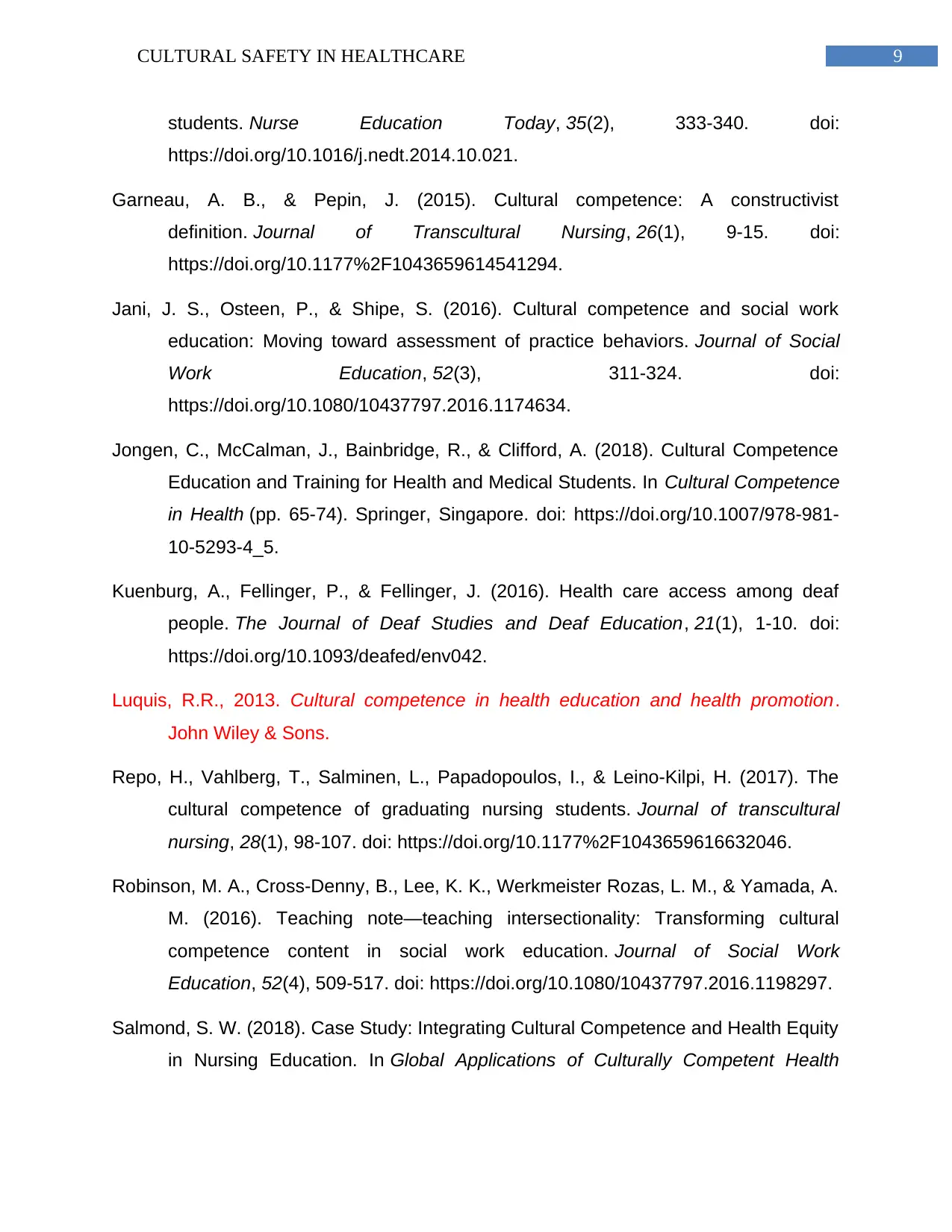
9CULTURAL SAFETY IN HEALTHCARE
students. Nurse Education Today, 35(2), 333-340. doi:
https://doi.org/10.1016/j.nedt.2014.10.021.
Garneau, A. B., & Pepin, J. (2015). Cultural competence: A constructivist
definition. Journal of Transcultural Nursing, 26(1), 9-15. doi:
https://doi.org/10.1177%2F1043659614541294.
Jani, J. S., Osteen, P., & Shipe, S. (2016). Cultural competence and social work
education: Moving toward assessment of practice behaviors. Journal of Social
Work Education, 52(3), 311-324. doi:
https://doi.org/10.1080/10437797.2016.1174634.
Jongen, C., McCalman, J., Bainbridge, R., & Clifford, A. (2018). Cultural Competence
Education and Training for Health and Medical Students. In Cultural Competence
in Health (pp. 65-74). Springer, Singapore. doi: https://doi.org/10.1007/978-981-
10-5293-4_5.
Kuenburg, A., Fellinger, P., & Fellinger, J. (2016). Health care access among deaf
people. The Journal of Deaf Studies and Deaf Education, 21(1), 1-10. doi:
https://doi.org/10.1093/deafed/env042.
Luquis, R.R., 2013. Cultural competence in health education and health promotion.
John Wiley & Sons.
Repo, H., Vahlberg, T., Salminen, L., Papadopoulos, I., & Leino-Kilpi, H. (2017). The
cultural competence of graduating nursing students. Journal of transcultural
nursing, 28(1), 98-107. doi: https://doi.org/10.1177%2F1043659616632046.
Robinson, M. A., Cross-Denny, B., Lee, K. K., Werkmeister Rozas, L. M., & Yamada, A.
M. (2016). Teaching note—teaching intersectionality: Transforming cultural
competence content in social work education. Journal of Social Work
Education, 52(4), 509-517. doi: https://doi.org/10.1080/10437797.2016.1198297.
Salmond, S. W. (2018). Case Study: Integrating Cultural Competence and Health Equity
in Nursing Education. In Global Applications of Culturally Competent Health
students. Nurse Education Today, 35(2), 333-340. doi:
https://doi.org/10.1016/j.nedt.2014.10.021.
Garneau, A. B., & Pepin, J. (2015). Cultural competence: A constructivist
definition. Journal of Transcultural Nursing, 26(1), 9-15. doi:
https://doi.org/10.1177%2F1043659614541294.
Jani, J. S., Osteen, P., & Shipe, S. (2016). Cultural competence and social work
education: Moving toward assessment of practice behaviors. Journal of Social
Work Education, 52(3), 311-324. doi:
https://doi.org/10.1080/10437797.2016.1174634.
Jongen, C., McCalman, J., Bainbridge, R., & Clifford, A. (2018). Cultural Competence
Education and Training for Health and Medical Students. In Cultural Competence
in Health (pp. 65-74). Springer, Singapore. doi: https://doi.org/10.1007/978-981-
10-5293-4_5.
Kuenburg, A., Fellinger, P., & Fellinger, J. (2016). Health care access among deaf
people. The Journal of Deaf Studies and Deaf Education, 21(1), 1-10. doi:
https://doi.org/10.1093/deafed/env042.
Luquis, R.R., 2013. Cultural competence in health education and health promotion.
John Wiley & Sons.
Repo, H., Vahlberg, T., Salminen, L., Papadopoulos, I., & Leino-Kilpi, H. (2017). The
cultural competence of graduating nursing students. Journal of transcultural
nursing, 28(1), 98-107. doi: https://doi.org/10.1177%2F1043659616632046.
Robinson, M. A., Cross-Denny, B., Lee, K. K., Werkmeister Rozas, L. M., & Yamada, A.
M. (2016). Teaching note—teaching intersectionality: Transforming cultural
competence content in social work education. Journal of Social Work
Education, 52(4), 509-517. doi: https://doi.org/10.1080/10437797.2016.1198297.
Salmond, S. W. (2018). Case Study: Integrating Cultural Competence and Health Equity
in Nursing Education. In Global Applications of Culturally Competent Health
Secure Best Marks with AI Grader
Need help grading? Try our AI Grader for instant feedback on your assignments.
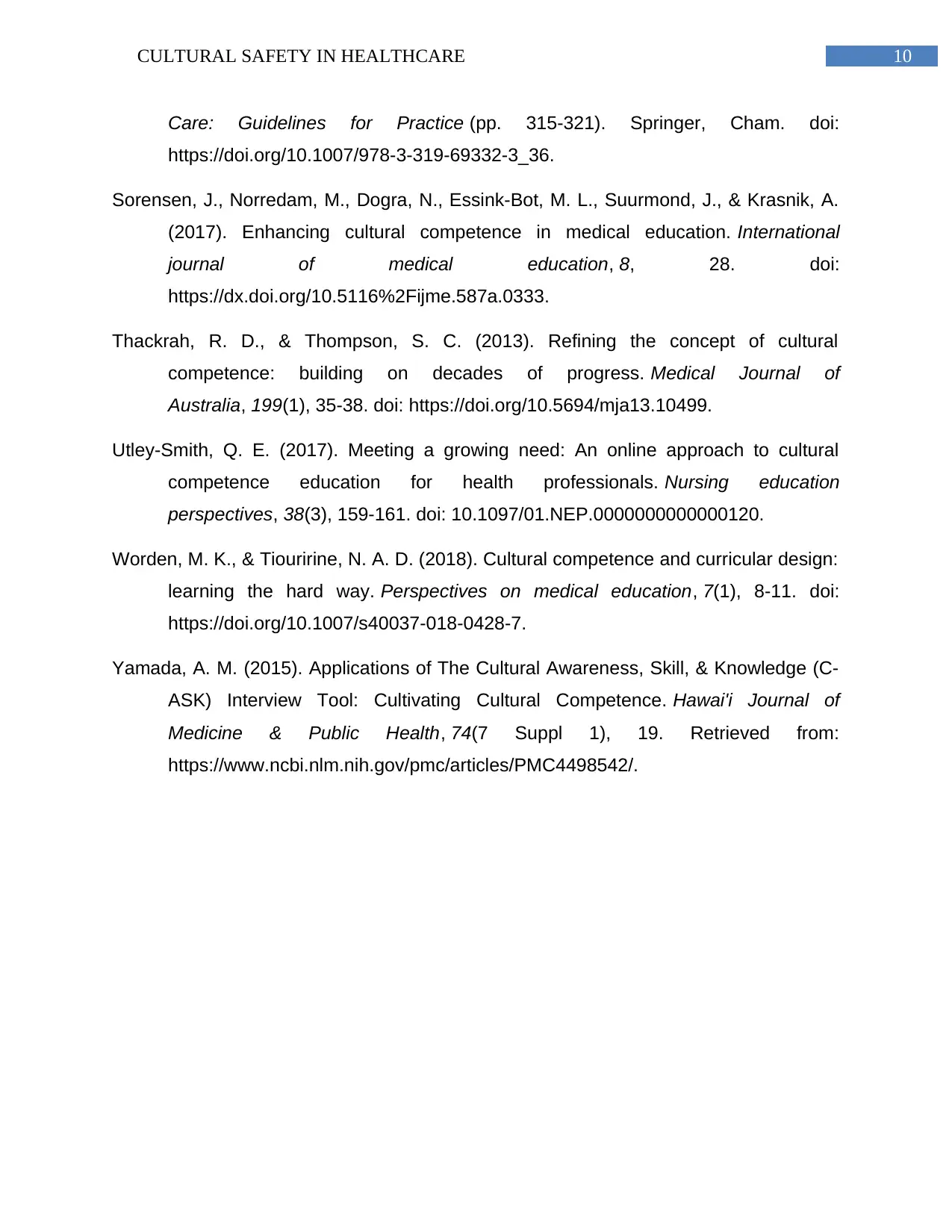
10CULTURAL SAFETY IN HEALTHCARE
Care: Guidelines for Practice (pp. 315-321). Springer, Cham. doi:
https://doi.org/10.1007/978-3-319-69332-3_36.
Sorensen, J., Norredam, M., Dogra, N., Essink-Bot, M. L., Suurmond, J., & Krasnik, A.
(2017). Enhancing cultural competence in medical education. International
journal of medical education, 8, 28. doi:
https://dx.doi.org/10.5116%2Fijme.587a.0333.
Thackrah, R. D., & Thompson, S. C. (2013). Refining the concept of cultural
competence: building on decades of progress. Medical Journal of
Australia, 199(1), 35-38. doi: https://doi.org/10.5694/mja13.10499.
Utley-Smith, Q. E. (2017). Meeting a growing need: An online approach to cultural
competence education for health professionals. Nursing education
perspectives, 38(3), 159-161. doi: 10.1097/01.NEP.0000000000000120.
Worden, M. K., & Tiouririne, N. A. D. (2018). Cultural competence and curricular design:
learning the hard way. Perspectives on medical education, 7(1), 8-11. doi:
https://doi.org/10.1007/s40037-018-0428-7.
Yamada, A. M. (2015). Applications of The Cultural Awareness, Skill, & Knowledge (C-
ASK) Interview Tool: Cultivating Cultural Competence. Hawai'i Journal of
Medicine & Public Health, 74(7 Suppl 1), 19. Retrieved from:
https://www.ncbi.nlm.nih.gov/pmc/articles/PMC4498542/.
Care: Guidelines for Practice (pp. 315-321). Springer, Cham. doi:
https://doi.org/10.1007/978-3-319-69332-3_36.
Sorensen, J., Norredam, M., Dogra, N., Essink-Bot, M. L., Suurmond, J., & Krasnik, A.
(2017). Enhancing cultural competence in medical education. International
journal of medical education, 8, 28. doi:
https://dx.doi.org/10.5116%2Fijme.587a.0333.
Thackrah, R. D., & Thompson, S. C. (2013). Refining the concept of cultural
competence: building on decades of progress. Medical Journal of
Australia, 199(1), 35-38. doi: https://doi.org/10.5694/mja13.10499.
Utley-Smith, Q. E. (2017). Meeting a growing need: An online approach to cultural
competence education for health professionals. Nursing education
perspectives, 38(3), 159-161. doi: 10.1097/01.NEP.0000000000000120.
Worden, M. K., & Tiouririne, N. A. D. (2018). Cultural competence and curricular design:
learning the hard way. Perspectives on medical education, 7(1), 8-11. doi:
https://doi.org/10.1007/s40037-018-0428-7.
Yamada, A. M. (2015). Applications of The Cultural Awareness, Skill, & Knowledge (C-
ASK) Interview Tool: Cultivating Cultural Competence. Hawai'i Journal of
Medicine & Public Health, 74(7 Suppl 1), 19. Retrieved from:
https://www.ncbi.nlm.nih.gov/pmc/articles/PMC4498542/.
1 out of 11
Related Documents
Your All-in-One AI-Powered Toolkit for Academic Success.
+13062052269
info@desklib.com
Available 24*7 on WhatsApp / Email
![[object Object]](/_next/static/media/star-bottom.7253800d.svg)
Unlock your academic potential
© 2024 | Zucol Services PVT LTD | All rights reserved.





